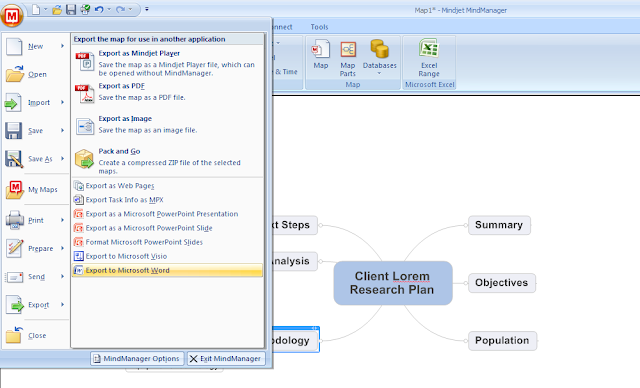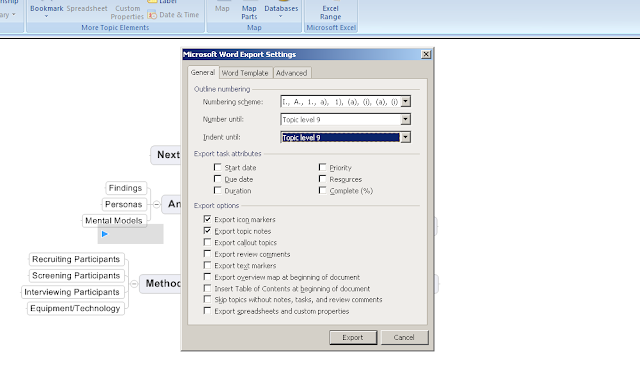To begin, open the MindManager application to create an outline for the research plan. Create a new map, and you'll end up with a single "topic shape" in the center. Rename the topic shape, "Client Lorem Research Plan" (replace "Client Lorem" with the client's actual name).
Continue by adding six sub-topics. Select topic shape, "Client Lorem Research Plan," and hit the "Enter" key six times. The result should end up looking like the screenshot below.
Rename the newly created sub-topics in the following order: Summary, Objectives, Population, Methodology, Analysis, and Next Steps.
Select the "Methodology" sub-topic, and hit the "Insert" key. Next, hit the "Enter" key three additional times. Rename the four sub-topics of "Methodology" to: Recruiting Participants, Screening Participants, Interviewing Participants, and Equipment/Technology.
Next, select the "Analysis" sub-topic, and create three sub-topics in the same manner as the newly created sub-topics of "Methodology." Rename these sub-topics, Findings, Personas, and Mental Models. The finished outline should look like the screenshot below.
 To generate the Microsoft Word version of the research plan outline, select the MindManager button from the application main menu (top), and then select "Export > Export to Microsoft Word."
To generate the Microsoft Word version of the research plan outline, select the MindManager button from the application main menu (top), and then select "Export > Export to Microsoft Word." After a prompt to save your file, you'll see a dialog box entitled, "Microsoft Word Export Settings." Change Microsoft Word settings be selecting options in the dropdown menus according to the screenshot below.
After a prompt to save your file, you'll see a dialog box entitled, "Microsoft Word Export Settings." Change Microsoft Word settings be selecting options in the dropdown menus according to the screenshot below. The result will be a Microsoft Word document that is a perfectly formatted outline for a research plan. Complete the research plan by adding appropriate detail to the topics described in the outline. Adding detail can be done in MindManager or Microsoft Word. The following describes the type of content that is needed for each section of the research plan:
The result will be a Microsoft Word document that is a perfectly formatted outline for a research plan. Complete the research plan by adding appropriate detail to the topics described in the outline. Adding detail can be done in MindManager or Microsoft Word. The following describes the type of content that is needed for each section of the research plan: 1. Summary- Briefly describe the research study. The summary should include any hypotheses, formed as a result of previous research, that the study will seek to validate. One of the objectives of the new research study should be to fill gaps in knowledge about the target audience.
2. Objectives- Outline the goals of the research. Describe how the research objectives support the overall business objectives. Explain how uncovering the informational needs and key behaviors of users will ultimately satisfy business objectives.
3. Population- Identify the desired user segments for the study. Describe and justify the sample size for each segment. Remember that the initial research population should reflect the demographic targeting of the business. The goal for the research, however, will be to group users by their key behavioral differences, resulting in behavioral personas.
4. Methodology- Describe every aspect of the end-user research study. The methodology should provide exhaustive detail about the following research tasks:
- Recruitment- Document the method for identifying and scheduling research participants. Here, you will need to mention any recruitment partners or online services, such as Google AdWords, used to identify candidates for the study. Recruitment is often handled by the client, especially if they have easier access to their audience, customers, or end-users.
- Screening- If targeting multiple user segments for the study, explain how these segments will be recruited and tagged. List questions that will be asked, either by phone or electronic screener, to evaluate candidates for the study.
- Interviews- It is of utmost importance to describe the flow, line-of-questioning, and environment for the research interview. Provide a rationale as to why the particular technique of choice was selected for the research study. To aid understanding, add a visualization or information graphic to illustrate the sequence/flow of the research interview.
- Honoraria- Provide detail about the incentive for the study.
- Equipment/Technology- Identify any audio/video equipment used to record the interviews, or software used to capture facial expressions and mouse clicks.
- High-Level Findings- Describe how the research analysis will yield high-level behavioral trends that may be true of many, or all, behavioral segments.
- Personas- Discuss the importance of aggregating findings by key behavioral differences, resulting in "behavioral personas." Personas will contain a brief description of the segment, as well as their key motivations, tasks, and behaviors.
- Mental Models- In this section, provide the client with a definition and description of the mental models that will be elevated in the research findings. Mental models are a visualization of the key tasks of each behavioral segment, accompanied with an identification of the type of content needed to satisfy each key task.
Research plans may vary according to the particulars of various client initiatives, but making sure the above topics are covered will ensure that the client is educated and understands the value of the research that they are being asked to pay for.




2 comments:
Just to say many thanks for this post. I'm trying to design my first piece of end user research and this was a neat how-to from the organizational perspective. I'll be referring to others of your articles as I work. Many thanks.
Well written article. Thank you
Post a Comment